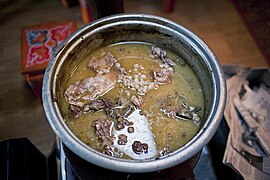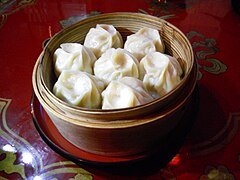Mongolian cuisine
This article needs additional citations for verification. (February 2011) |

Mongolian cuisine predominantly consists of dairy products, meat, and animal fats. The most common rural dish is cooked mutton. In the city, steamed dumplings filled with meat—"buuz"— are popular.
The extreme
History
Details of the historic cuisine of the Mongolian court were recorded by
Court cuisine
Influences
Nomadic
Little is known of the early Mongol cuisine, other than the assumption that it would be similar to the general
As far as hunting, Mongols hunted the wild animals of the
| English | Mongol | Latin |
|---|---|---|
| Scarlet lily bulbs | ja'uqasun | Lilium concolor |
| Garden burnet root | südün | Sanguisorba officinalis |
| Wild apple | ölirsün | Probably Malus pallasiana |
| Bird cherries | moyilsun | Prunus padus |
| Chinese chives | qoqosun | Allium tuberosum |
| Wild garlic | qaliyarsun | Allium victorialis |
| Wild onions | manggirsun | Allium senescens |
| Cinquefoil root | cicigina | Potentilla anserina
|
China
The Yinshan Zhengyao features recipes with Central Asian influence, mostly in north China. Some difference continues in the present day and dishes with lamb, fancy breads and fried dumplings are more typical of north Chinese cuisine, while fish, rice, pork and vegetables are more common in the south.
Muslim
Some recipes in Yinshan Zhengyao are similar to recipes from medieval Arabic cookbooks. Scholars have proposed a possible West to East diffusion of the cookbook. Of the extant cookbooks, the Arab texts are the earliest and the similarity of Yinshan Zhengyao along with the timing of its compilation after the Mongol conquests may support a West to East diffusion or direct influence upon the Yinshan Zhengyao content, but there is no way to rule out the possibility of an independent Chinese origin.[8] Lactic acid fermentation was used to preserve dairy products like the dried yogurt called kashk in Iran and qimaq in the Yinshan Zhengyao.
Features
The
The nomads in the countryside are self-supporting on principle. Travelers will find
Common foods
The most common rural dish is cooked
-
Boiled meat and innards; the most common meal in a herder's household
-
Another Buuz variant
-
Khorkhog
-
Boodog
The most surprising cooking method is only used on special occasions. In this case, the meat (often together with vegetables) gets cooked with the help of stones, which have been preheated in a fire. This either happens with chunks of mutton in a sealed milk can (khorkhog), or within the abdominal cavity of a deboned goat or marmot (boodog).
Milk is boiled to separate the cream (öröm,
-
Süütei Tsai, salted milk tea
-
Three large stones removing excess liquid from a cheese, Khövsgöl Province
-
A glass of airag in front of the plastic barrel used to make it
-
Leather pouch used for fermenting airag the traditional way
-
Various types of Mongolian sour milk sweets
-
Aaruul in the process of drying on top of a ger
-
Aaruul in a serving bowl
-
Boortsog type of fried dough
Horse meat is eaten in Mongolia and can be found in most grocery stores.
Mongolian sweets include boortsog, a type of biscuit or cookie eaten on special occasions.
Custom of hospitality
The Mongol people had rules of hospitality and social support similar to the Germanic Gastfreundschaft (where it was customary to extend hospitality even to enemies) and Arab Bedouin hospitality. An account of this survives in the Secret History of the Mongols:
After that, when Dobun-mergen one day went to hunt on Toqocaq Rise, he encountered Uriangqadai people in the forest. They had killed a three year old deer and were cooking its ribs and intestines. When Dobun-mergen spoke he said: "Please give me (some meat) as the share of meat due another (nökör sirolqa ke'ejü'ü)." Taking [only] half a breast side of the meat with the lungs, and the hide, they gave all (the rest of the) three year old deer's meat to Dobun-mergen.
References
- Marshall Cavendish Corporation (2007) World and Its Peoples: Eastern and Southern Asia, ISBN 0-7614-7633-4
- Buell, P.D. (2010) A Soup for the Qan: Second Revised and Expanded Edition ISBN 9789004180208














